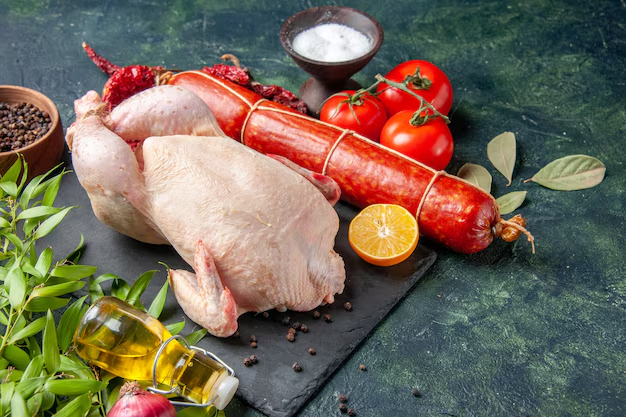How Long Can You Safely Store Raw Chicken in the Fridge?
Have you ever stared into your refrigerator, uncertain about whether the raw chicken you bought earlier in the week is still safe to cook? If so, you're not alone. Many people grapple with food storage questions daily, particularly when it comes to perishable items like chicken. Understanding the shelf life of raw chicken in the refrigerator not only ensures delicious meals but plays a critical role in promoting food safety in your home. So, just how long can you keep raw chicken in the fridge before it becomes unsafe to eat?
🥶 Understanding Raw Chicken Storage Basics
Why Does Chicken Spoil?
Raw chicken is a rich source of nutrition for us, but it's also an ideal breeding ground for bacteria. These microorganisms can multiply rapidly when the chicken is stored improperly, leading to spoilage. Factors such as temperature, humidity, and time can affect how quickly spoilage occurs, making it essential to know how to store chicken correctly.
Optimal Storage Conditions
For best results, store raw chicken in the refrigerator at 40°F (4°C) or below. This temperature range significantly slows bacterial growth, ensuring your chicken stays fresh for as long as possible. Always store chicken in its original packaging or transfer it to an airtight container to prevent exposure to air and moisture.
⏰ Shelf Life of Raw Chicken
General Timeline
- Whole chicken: Typically remains safe for 1-2 days in the refrigerator.
- Chicken pieces (breasts, thighs, wings): Similar to whole chicken, pieces can last 1-2 days.
- Ground chicken: Follow the same 1-2 day guideline to ensure freshness.
While these are standard recommendations, keep in mind that freshness can vary slightly based on refrigeration settings and packaging.
Signs of Spoilage
It’s important to recognize the signs of spoiled chicken to avoid unpleasant and potentially harmful foodborne illnesses. Check for these indicators:
- Changes in color: Spoiled chicken often goes from pink to a grayish hue.
- Unpleasant odor: Fresh chicken has a mild smell, whereas spoiled chicken has a sour or ammonia-like odor.
- Altered texture: If the chicken feels slimy or sticky, it's time to discard it.
🧊 Extending Shelf Life: Freezing Chicken
Freezing Techniques
If you find yourself with chicken that you can't consume within the recommended timeframe, freezing is an excellent option. Proper freezing techniques include:
- Wrap tightly: Use heavy-duty freezer bags or airtight containers to minimize exposure to air.
- Label and date: Clearly mark the date of freezing to keep track of its shelf life.
How Long Can Chicken Last in the Freezer?
- Whole chicken: Can be stored for up to 1 year.
- Chicken pieces: Suitable for up to 9 months.
- Ground chicken: Best used within 3-4 months.
Freezing halts bacterial growth entirely, so frozen chicken remains safe indefinitely when kept frozen. However, quality may begin to degrade beyond these periods.
🥩 Thawing Your Frozen Chicken
Safe Thawing Methods
When you’re ready to cook frozen chicken, ensure you follow safe thawing practices to maintain safety and quality:
- Refrigerator thawing: This method takes up to 24 hours for pieces and longer for whole chickens, but it’s the safest way to thaw chicken while keeping it at a safe temperature.
- Cold water thawing: Immerse the chicken in cold water, changing the water every 30 minutes. This method is faster but requires more attention.
- Microwave thawing: Use this method only if cooking immediately, as microwaves can start the cooking process.
Avoid These Thawing Mistakes
- Room temperature thawing: Never thaw chicken on the countertop, as this allows bacteria to grow rapidly.
- Warm water thawing: This accelerates bacterial growth and can lead to unsafe food.
🌡️ Cooking Raw Chicken Safely
Internal Temperatures
To ensure safety, cook chicken to a minimum internal temperature of 165°F (74°C). Use a meat thermometer to verify the temperature at the thickest part of the chicken.
Tips for Safe Cooking
- Avoid cross-contamination: Use separate cutting boards for raw chicken and other foods.
- Clean surfaces: Sanitize all kitchen surfaces and utensils after contact with raw chicken.
- Timely consumption: Cooked chicken should be consumed immediately or cooled and refrigerated within two hours.
📝 Quick Reference Summary
Here's a handy guide to chicken storage and safety:
| Practice | Recommended Action |
|---|---|
| Refrigerator Storage | 1-2 days for raw; store at 40°F (4°C) or below |
| Freezing | Freeze if not using within 2 days; up to 1 year for whole chicken |
| Spoilage Signs | Gray color, sour smell, slimy texture |
| Safe Thawing | Thaw in the fridge or with cold water; never at room temperature |
| Cooking Temperature | Cook to 165°F (74°C) |
🛡️ Practical Tips
- Plan ahead: Buy chicken with a meal plan in mind to avoid last-minute storage concerns.
- Use labels: Label frozen chicken with the purchase date for the best quality use.
- Stay aware of fridge settings: Occasionally check your refrigerator to ensure it's at the correct temperature.
🏁 Wrapping Up
Maintaining proper storage practices for raw chicken is crucial for both maximizing usage and ensuring safety. By adhering to recommended storage timelines and conditions, you can enjoy fresh, delicious chicken meals without risking spoilage or foodborne illnesses. Keep this guide handy, and you'll never have to second-guess the freshness of your raw chicken again.
